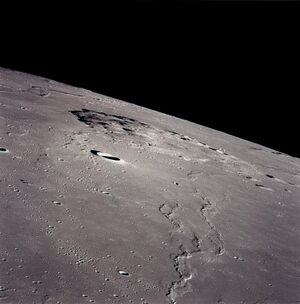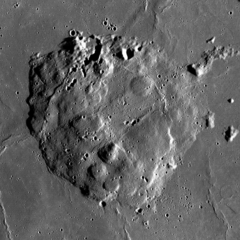Astronomy:Mons Rümker
| Mons Rümker | |
|---|---|
| Named for Karl L. C. Rümker | |
 View of Mons Rümker from Apollo 15 | |
| Highest point | |
| Elevation | 1.3 km (0.81 mi) 4,265 ft (1,300 m) |
| Listing | Lunar mountains |
| Coordinates | [ ⚑ ] 40°48′N 58°06′W / 40.8°N 58.1°W |
| Naming | |
| English translation | Rümker Mountain |
| Language of name | Latin |
| Geography | |
| Location | Near side of the Moon |
| Geology | |
| Mountain type | Lunar dome |
Mons Rümker is an isolated volcanic formation that is located in the northwest part of the Moon's near side, at selenographic coordinates 40.8° N, 58.1° W. The feature forms a large, elevated mound in the northern part of the Oceanus Procellarum.[1] The mound has a diameter of 70 kilometres, and climbs to a maximum elevation of about 1,300 metres above the surrounding plain.[1] It was named after Karl L. C. Rümker.
Mons Rümker has a concentration of 22 lunar domes—rounded bulges across the top, some of which contain a small craterlet at the peak. These are wide, circular features with a gentle slope rising in elevation a few hundred meters to the midpoint.[1] Lunar domes are similar to shield volcanoes, and are the result of lava erupting from localized vents followed by relatively slow cooling.[2]
Mons Rümker is surrounded by a scarp that separates it from the adjacent mare. The plateau rises to an altitude of 900 m in the west, 1,100 m in the south and 650 m in the east. The surface of Mons Rümker is relatively uniform, with a strong spectroscopic signature of lunar mare material. The estimated volume of lava extruded to create this feature is 1,800 km3.[3]
A young lava plain to the northeast from Mons Rümker, named Statio Tianchuan, was the landing site of the Chang'e 5 mission.[4]
See also
- List of mountains on the Moon by height
- Volcanism on the Moon
References
- ↑ 1.0 1.1 1.2 Zhao, Jiannan; Xiao, Long; Qiao, Le; Glotch, Timothy D.; Huang, Qian (June 27, 2017). "The Mons Rümker volcanic complex of the Moon: A candidate landing site for the Chang'E-5 mission" (in en). Journal of Geophysical Research: Planets 122 (7): 1419–1442. doi:10.1002/2016je005247. ISSN 2169-9097. Bibcode: 2017JGRE..122.1419Z. https://agupubs.onlinelibrary.wiley.com/doi/epdf/10.1002/2016JE005247.
- ↑ "A Little Guide to Lunar Domes - Sky & Telescope" (in en-US). Sky & Telescope. 2016-09-07. https://www.skyandtelescope.com/observing/a-little-guide-to-lunar-domes/.
- ↑ Wöhler, C.; Lena, R.; Pau, K. C. (March 12–16, 2007). "The Lunar Dome Complex Mons Rümker: Morphometry, Rheology, and Mode of Emplacement". League City, Texas: Dordrecht, D. Reidel Publishing Co. http://www.lpi.usra.edu/meetings/lpsc2007/pdf/1091.pdf. Retrieved 10 March 2017.
- ↑ Jones, Andrew (8 July 2021). "China's Chang'e 5 moon landing site finally has a name". Space.com. https://www.space.com/china-chang-e-5-moon-landing-site-name.
[ ⚑ ] 40°48′N 58°06′W / 40.8°N 58.1°W
 |


